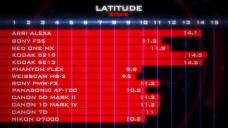
How to checked the video dynamic range?
-
how they make conclution about this chart
http://www.personal-view.com/talks/uploads/FileUpload/22/42a2254b720cbd8cc72a1b9b4c1344.jpg
any article to explain about the gain latitude stop?so i'm confuse now..
thanks to explain me

 latitude.jpg660 x 371 - 94K
latitude.jpg660 x 371 - 94K -
Take a 50% grey (aka 18% grey) chart (any evenly painted grey thing will do) and start exposing it at -10, -9 -8 .....0 +1+2....+10 stops in the controlled light at all manual settings with all the auto processing turned off. Then in Photoshop, or the color grading app of your choice start grading each separate footage/file until it has the same number/values (looks the same) as a +-0 file without too large of a color shift. Then see which of the exposures on the --- side have maximum acceptable noise/artifacts/color shifts - this will define your blacks range; then which one of the exposures on the ++++ side clips to full white so it can't be graded back to grey - this will define your whites range. Then count number of stops between those two and, voila - you have you custom dynamic range rating for you camera. Repeat at different ISOs for the full picture.
Hope it helps -
-
by the way the zacuto test, even though it is the best test made so far no doubt, is still very flawed, and ofourse, us gh2 ers can't make any solid conclusions. And before you ask, the AF100 behaves significantly differently in DR compared to gh2.
I think very high DR above 10 stops is vastly OVERestimated and I think smooth and noiseless DR is vastly UNDERestimated. +, if you're not a good colorist who understands DR and selective manipulation, 18 stops of lattitude in RED's HDRX will look like shit 99% of times -
nope, there's no application. The question you need to answer first is what level of accuracy you are aiming for and how scientific do you want and can afford the result to be. If you want scientific results, you need to use special charts which again can vary a lot in pricerange. If you want a mediocre level of accuracy without breaking the bank, you can find charts and print one the best you can and count the stops. But there are just so many variables to consider it can get quite complicated. For example, if you test yourself a gh2 and find that it's 10 stops, you can't really look at another external test of a 5d for instance and properly compare them, that's why you need to test the cameras under the same test to get fair and useful results. then you need to consider how the DR actually looks like. For instance a technicolor 5d2 might show many more stops in shadows, but if those stops are fucked up with noise, those stops might not really be useful. Or how the highlights clip is important. I bet my ass that the gh2 will show more stops of overexposure on a chart if using the cinema profile, but the slight detail you might gain from the cinema profile in highlights is so overstaurated and harsh, that i don't give a shit if it shows 0.5 stops more DR, I'd much rather use nostalgic and get very pretty and filmic highlight roll-off.
In other words, if you're not a pro, just do the best cross research u can from tests others have done and slowly try to come to conclusions.
Start New Topic


Howdy, Stranger!
It looks like you're new here. If you want to get involved, click one of these buttons!
Categories
- Topics List23,993
- Blog5,725
- General and News1,354
- Hacks and Patches1,153
- ↳ Top Settings33
- ↳ Beginners256
- ↳ Archives402
- ↳ Hacks News and Development56
- Cameras2,368
- ↳ Panasonic995
- ↳ Canon118
- ↳ Sony156
- ↳ Nikon96
- ↳ Pentax and Samsung70
- ↳ Olympus and Fujifilm102
- ↳ Compacts and Camcorders300
- ↳ Smartphones for video97
- ↳ Pro Video Cameras191
- ↳ BlackMagic and other raw cameras116
- Skill1,960
- ↳ Business and distribution66
- ↳ Preparation, scripts and legal38
- ↳ Art149
- ↳ Import, Convert, Exporting291
- ↳ Editors191
- ↳ Effects and stunts115
- ↳ Color grading197
- ↳ Sound and Music280
- ↳ Lighting96
- ↳ Software and storage tips266
- Gear5,420
- ↳ Filters, Adapters, Matte boxes344
- ↳ Lenses1,582
- ↳ Follow focus and gears93
- ↳ Sound499
- ↳ Lighting gear314
- ↳ Camera movement230
- ↳ Gimbals and copters302
- ↳ Rigs and related stuff273
- ↳ Power solutions83
- ↳ Monitors and viewfinders340
- ↳ Tripods and fluid heads139
- ↳ Storage286
- ↳ Computers and studio gear560
- ↳ VR and 3D248
- Showcase1,859
- Marketplace2,834
- Offtopic1,320
Tags in Topic
- hdslr 15




